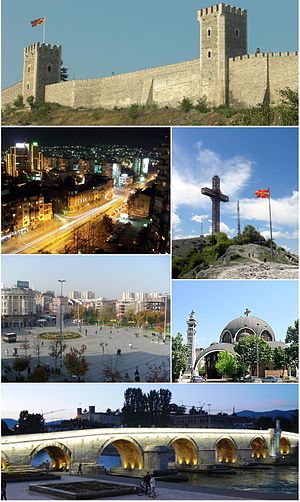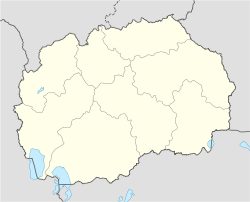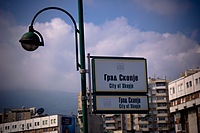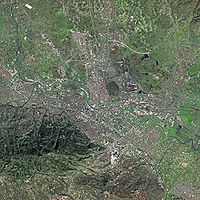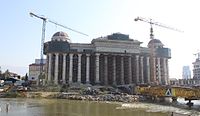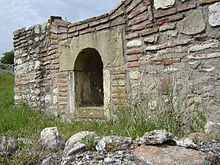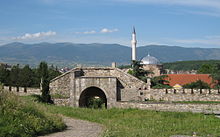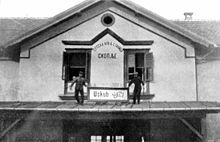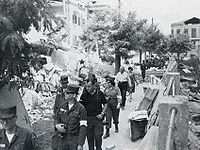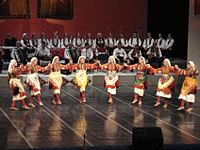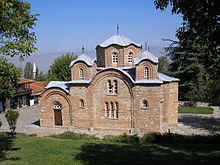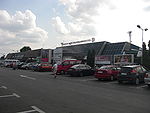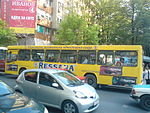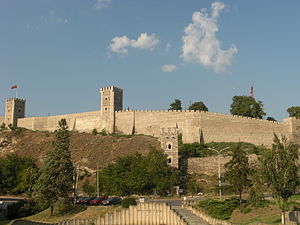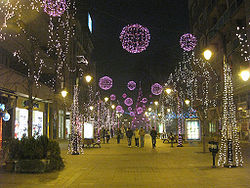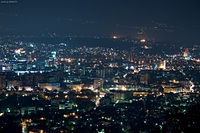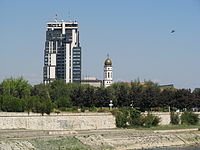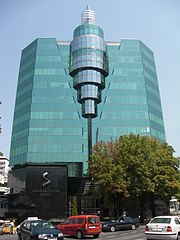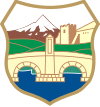- Skopje
-
Skopje
Скопје— City — City of Skopje
Град СкопјеTop: Kale Fortress. 2nd row: Makedonija Street, Millennium Cross. 3rd row: Macedonia Square, St. Clement of Ohrid Church. Bottom: Stone Bridge 
Flag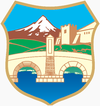
Coat of armsLocation of the city of Skopje in Macedonia Coordinates: 42°0′N 21°26′E / 42°N 21.433°ECoordinates: 42°0′N 21°26′E / 42°N 21.433°E Country  Macedonia
MacedoniaMunicipality  Greater Skopje
Greater SkopjeGovernment - Mayor Koce Trajanovski
(VMRO-DPMNE)Area - Total 571.46 km2 (220.6 sq mi) Elevation 240 m (787 ft) Population (2006)[1] - Total 668,518 - Density 1,169.8/km2 (3,029.9/sq mi) Time zone CET (UTC+1) - Summer (DST) CEST (UTC+2) Postal codes 1000 Area code(s) +389 02 Car plates SK Patron saint Virgin Mary Website skopje.gov.mk Skopje (Macedonian: Скопје, [ˈskɔpjɛ] (
 listen)) is the capital and largest city of the Republic of Macedonia with about a third of the total population. It is the country's political, cultural, economic, and academic centre. It was known in the Roman period under the name Scupi.
listen)) is the capital and largest city of the Republic of Macedonia with about a third of the total population. It is the country's political, cultural, economic, and academic centre. It was known in the Roman period under the name Scupi.The territory of Skopje has been inhabited since at least 4000 BC; remains of Neolithic settlements have been found within the old Kale Fortress that overlooks the modern city centre. On the eve of the 1st century AD, the settlement was seized by the Romans and became a military camp.[2][3] When the Roman Empire was divided into eastern and western halves in 395 AD, Scupi came under Byzantine rule from Constantinople. During much of the early medieval period, the town was contested between the Byzantines and the Bulgarian Empire. From 1282 the town was part of the Serbian realm and its capital city since 1346. In 1392 the city was conquered by the Ottoman Turks who called the town Üsküp. The town stayed under Ottoman control over 500 years. At that time the city was famous for its oriental architecture. In 1912 the city was conquered by the Kingdom of Serbia during the Balkan Wars and after the First World War the city became part of the newly formed Kingdom of Serbs, Croats and Slovenes (Kingdom of Yugoslavia). In the Second World War the city was conquered by the Bulgarian Army, which was part of Axis powers. In 1944 it became the capital city of Democratic Macedonia (later Socialist Republic of Macedonia), which was a federal state, part of Democratic Federal Yugoslavia (later Socialist Federal Republic of Yugoslavia). The city developed rapidly after World War II, but this trend was interrupted in 1963 when it was hit by a disastrous earthquake. In 1991 it became the capital city of independent Macedonia.
Skopje is located on the upper course of the Vardar River and is located on a major north-south Balkan route between Belgrade and Athens. It is a center for metal-processing, chemical, timber, textile, leather, and printing industries. Industrial development of the city has been accompanied by development of the trade, logistics, and banking sectors, as well as an emphasis on the fields of culture and sport. According to the 2006 official estimate, it has 668,518 inhabitants.
Contents
Etymology
See also: other names of SkopjeThe name of Skopje is derived from an ancient name that is attested in antiquity as Latin Scupi, the name of a classical era Greco-Roman frontier fortress town[4] of Thracian (Paeonian) origin.[5][6] In modern times, the city has been known by its Ottoman Turkish name Üsküp (Ottoman Turkish: اسكوب) during the time of Ottoman rule and by the Serbian form Skoplje (Скопље) during the time of the Royal Yugoslavia between 1912 and 1941. Under the Kingdom of Bulgaria (1941–1944), the city was called Skopie (Скопие). Since 1945, the official name of the city in Macedonian has been Skopje (Скопје), reflecting the Macedonian Cyrillic orthography for the local pronunciation. The city is called Shkup or Shkupi in Albanian.
Geography
Skopje is located in the in the Skopje statistical region of northern Macedonia, in the centre of the Balkans, approximately halfway between Belgrade and Athens. The Vardar River, which originates near Gostivar, flows through the city then flows south passing the border into Greece and eventually flowing into the Aegean Sea. The Vardar valley consists primarily of hills and mountains. The city covers an average length of 23 km from east to west and 9 km from north to south. Skopje is located at an elevation of 225 m (738 ft) above sea level. The city's land area is 1,854 km2 (716 sq mi).
Climate
The city experiences a humid subtropical climate (Köppen Cfa) and lies near the boundary of the humid continental climate. The summers are hot and humid, while the winters are cold, wet, and often snowy. In summer, temperatures are usually above 31 °C (88 °F) and sometimes above 40 °C (104 °F). In spring and autumn, the temperatures range from 15 to 24 °C (59 to 75 °F). In winter, the day temperatures are roughly 6 °C (43 °F), but at nights they often fall below 0 °C (32 °F) and sometimes below −10 °C (14 °F). Occurrences of precipitation are evenly distributed throughout the year, being heaviest from October to December and from April to June.
Climate data for Skopje (1971-1990) Month Jan Feb Mar Apr May Jun Jul Aug Sep Oct Nov Dec Year Average high °C (°F) 4.3
(39.7)8.4
(47.1)13.8
(56.8)18.5
(65.3)23.7
(74.7)27.5
(81.5)30.0
(86.0)30.0
(86.0)26.0
(78.8)19.3
(66.7)10.2
(50.4)5.1
(41.2)18.07
(64.52)Average low °C (°F) −3.4
(25.9)−1.3
(29.7)1.9
(35.4)5.4
(41.7)9.9
(49.8)13.1
(55.6)14.9
(58.8)14.6
(58.3)11.3
(52.3)6.3
(43.3)1.3
(34.3)−2.4
(27.7)5.96666667
(42.74)Precipitation mm (inches) 33.6
(1.323)37.2
(1.465)35.8
(1.409)40.4
(1.591)61.8
(2.433)45.9
(1.807)33.6
(1.323)31.3
(1.232)41.0
(1.614)44.0
(1.732)56.3
(2.217)46.1
(1.815)507
(19.96)Avg. precipitation days 6 6 6 7 9 6 5 5 5 6 7 7 75 Source: [7] Hydrography
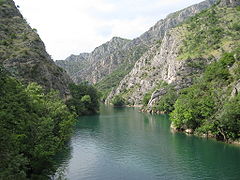 The Matka Canyon.
The Matka Canyon.
In Skopje, the Vardar River is sixty miles from its source near Gostivar. The flow in the city is almost equivalent to the flow at its delta, near Thessaloniki. The river makes a few large meanders in Skopje and is crossed by several bridges, five in the centre of the city.
Several rivers flow into the Vardar in Skopje. The longest is the Treska, which is 130 km long. Others include the Lepenec, Pčinja, Kadina Reka, Markova Reka and Pateška, which are all less than 70 km long.[8]
Skopje's two artificial lakes Matka and Treska are supplied by the Treska River, located just few kilometers outside the city center. The city also has a glacial lake called Jakupica.[8]
Geology
Seismic movements have formed medium-sized mountains around the city. The city of Skopje is bordered by Šar Mountains to the west, by the Jakupica chain to the south, and by hills to the east that form the early Osogovo Mountains, which are situated on the border between Macedonia and Bulgaria.[8]
The highest point in the center of Skopje is at an altitude of 1066 meters which is far exceeded by the mountains Osoj, Skopska Crna Gora, and Žeden which have heights of 1506 meters, 1260 meters and 1561 meters respectively.[8]
Some rivers, like the Matka, have created ravines around the city. The canyon of the Treska River is surrounded by some caves.[8]
Town planning
Skopje has a rather loose town planning, which is the result of an earthquake that destroyed 80% of the city in 1963.[9][10]
The centre of Skopje is formed of two municipalities separated by the Vardar. On the north bank of the river is Čair Municipality in which the Old Town is located, while the on the south bank is Centar Municipality which is the modern part of the centre of the city.
Rebuilding after the earthquake was largely orchestrated by Kenzo Tange,[11] a Japanese architect and urban planner who had drawn many plans for cities and towns including that for Hiroshima in 1949. The most significant accomplishment was the train station, which was built on an elevated platform over bridges and allows for the separation of traffic and pedestrians. The planning of the southern bank of the Vardar has been designed to accommodate 1,800 homes lost in the earthquake.[11]
The combination of the earthquake, Yugoslav social planning, and UN funded plans created an environment in Skopje for some unusual building projects from the mid-1960s onwards. A notable example is the central post office, a circular building which was designed by architect Janko Konstantinov.[12]
Today, the city is spreading in all directions and is experiencing a number of new developments.[13] The government has made plans to erect several statues, fountains, bridges, and museums at a cost of about €200 million. The project has generated controversy. Critics have described the new landmark buildings as signs of a reactionary historicist esthetics.[14] The project has also been criticised for its cost and for the lack of representation of national minorities in the coverage of its set of statues and memorials.[14]
History
Main article: History of SkopjeThe site of modern Skopje has been inhabited since at least 4000 BC.[8] Remains of Neolithic settlements have been found within the Skopje Fortress. The earliest people in Skopje Valley were probably the Triballi.[15] Later the area was populated by the Paionians, but in the 3rd century BC, Skopje and the surrounding area was invaded by the Dardanians. Scupi, the ancient name for Skopje, became the capital of Dardania, which extended from Naissus to Bylazora in the second century BC.[16] Roman expansion east brought Scupi under Roman rule as a colony of legionnaires, mainly veterans of the Legio IIV Claudia in the time of Domitian (81-96 AD). However, several legions from the Roman province of Macedonia of Crassus' army may already have been stationed in there around 29-28 BC, before the official imperial command was instituted.[17][18] Shortly afterwards it became part of the province of Moesia during Augustus's rule.[19] After the division of the province by Domitian in 86 AD, Scupi was elevated to colonial status, and became a seat of government within the new province of Moesia Superior. The district called Dardania (within Moesia Superior) was formed into a special province by Diocletian, with the capital at Naissus. From 395 AD, it passed into the hands of the Byzantine Empire. Scupi was probably a metropolitan seat during the middle of the 5th century.(Latin: Archidioecesis Scopiensis).[20]
After becoming part of the Byzantine Empire, Scupi became an important regional trading and garrison. Byzantine Emperor Justinian (527–65 AD) was born in Tauresium,[21] a town situated roughly 20 km southeast of present-day Skopje, in 483 AD. After Scupi was almost completely destroyed by an earthquake in 518 AD, Justinian, according to his historian Procopius in "De Aedificiis" (On the Buildings), built a new city near his birthplace Tauresium and Bederiana[22] (believed to be today's villages Taor and Bader) at the fertile entry point of the River Lepenec into the Vardar, making Skopje the city of Justiniana Prima.[23][24] During much of the early medieval period, the town was contested by both the Byzantines and the Bulgarian Empire. From 972 to 992, it was the capital of the First Bulgarian Empire.[25] After 1018, it was the capital of the Byzantine administrative region (katepanat) of Bulgaria after the fall the First Bulgarian Empire in 1018. Skopje was a thriving trading settlement but fell into decline after being hit by another earthquake at the end of the 11th century. In 1189, the town was briefly occupied by the Serbs.[26]
Skopje was the capital of the estate of the Bulgarian feudal lord, later Emperor Konstantin Asen in the middle of 13th century. The Byzantine Empire took advantage of the decline in Skopje to regain influence in the area, but lost control of it once again in 1282 to King Stefan Uroš II Milutin of Serbia. Milutin's grandson, Stefan Dušan, made Skopje his capital. He later proclaimed himself Emperor of Serbs and Greeks[8] in 1346, subsequently making Skopje capital of the Serbian Empire. After his sudden death in 1355, he was succeeded by Stephen Uroš V of Serbia who could not keep Serbian Empire together and it was fragmented in many small principalities. Vuk Branković was the last Serbian and Christian prince to rule Skopje during medieval period.
After conquering some parts of the Balkans, the Ottoman Turks conquered Skopje in 1392 beginning 520 years of Ottoman rule.[27][28] The Ottomans named the town Üsküb. At first, the Ottomans established Sanjak of Skopje with Skopje (Üsküb) as its seat. Üsküb was strategically important for further expansion into central Europe. Under Ottoman rule, the town expanded further towards the confluence point of the Serava and Vardar rivers. The city soon had a large Muslim population and the architecture of the town changed accordingly. During the 15th century, many travelers'inns, such as Kapan An and Suli An, were established in the town. The city's famous Stone Bridge was also reconstructed during this period and the Daut Pasha baths was built at the end of the 15th century. Also at this time, numerous Sephardic Jews driven out of Spain settled in Üsküb, adding to the cultural mix of the town and enhancing the town's trading reputation.[8]
At the beginning of Ottoman rule, several mosques sprang up in the city, and church lands were often seized and given to ex-soldiers, while many churches themselves were converted over time into mosques.[29] Üsküb was briefly occupied in 1689 by the Austrian General Piccolomini. He and his troops did not stay for long, however, as the town was quickly engulfed by the plague. On retreating from the town Piccolomini's troops set fire to Üsküb, perhaps in order to stamp out the plague, although some say this was done in order to avenge the 1683 Ottoman siege of Vienna.[8] For the next two centuries Üsküb's prestige waned and by the 19th century its population had dwindled to a mere 10,000. In 1873, however, the completion of the Üsküb—Selanik (now Skopje—Thessaloniki) railway brought many more travelers and traders to the town, so that by the turn of the century Üsküb had regained its former numbers of around 30,000.[8] In the 19th century the greater Macedonian region was divided into three vilayets: Kosovo (with Üsküb as capital), Manastir and Selanik. Towards the end of the Ottoman Empire, Üsküb, along with other towns in Macedonia – Kruševo and Manastir (now Bitola) – became main hubs of rebellious movements against Ottoman rule. Üsküb was a key player in the Ilinden Uprising of August 1903 when the native population of the region declared the emergence of the Kruševo Republic. While the Kruševo Republic lasted only ten days before being quelled by the Ottomans, it was a sign of the beginning of the end for Ottoman rule. Some of the Ottomans were expelled from the city on 12 August 1912 by the local Albanian population when 15,000 Albanians marched on Üsküb.[30][31]
The Ottoman army could not stand against the united front of Montenegro, Greece, Serbia and Bulgaria during the First Balkan War. When reinforcements to the Serbian royal army arrived some weeks later during the Battle of Kumanovo (50 km northeast of Skopje) it proved decisive in firmly driving out the Ottomans from all of Macedonia.[27][32] In 1912, the Kingdom of Serbia occupied Skopje and the official name of the city was changed from the Turkish name Üsküb to the Serbian name Skoplje (Скопље). The Treaty of London of 1913 legitimated Serbian authority in contemporary Macedonia.[33] Skopje remained under rule of the Kingdom of Serbia[33] during the Second Balkan War of 1913 when the formerly united front started to fight amongst themselves. After the outbreak of World War I in 1915 the town was occupied by the Kingdom of Bulgaria. By 1918 it became part of the newly formed Kingdom of Serbs, Croats, and Slovenes, and remained so until 1939, apart from a brief period of six months in 1920 when Skopje was controlled by the Yugoslav Communist Party. An ethnic Serb ruling elite dominated over the rest, initiating the repression, inconceivable by previous Ottoman rulers, aimed to destroy Macedonian nationalism.[34] In 1931, in a move to formally decentralize the country, Skopje was named the capital of the Vardar Banovina of the Kingdom of Yugoslavia.
In March 1941 when Yugoslavia entered the war, there were huge anti-war demonstrations in the streets of the town.[35] Skopje came under German occupation on 7 April 1941[36] and was later occupied by Bulgarian forces.[37] As part of a broader 'Bulgarisation' campaign, the occupying forces established a national theatre, a library, a museum and for higher education - the King Boris University.[38]
On 11 March 1943, Skopje's entire Jewish population of 3,286 was deported to the gas chambers of Treblinka concentration camp in German-occupied Poland.[39][40] This was in stark contrast to the way Bulgaria handled its own Jewish population.[41]
Skopje was liberated on 13 November 1944 by Yugoslav Partisan units of the Macedonian National Liberation Army, together with units of the newly allied Bulgarian People's Army (Bulgaria having switched sides in the war in September).[42][43][44] Soon after, Skopje became the capital of the newly established People's Republic of Macedonia within the Yugoslavia.
Until 1991 Skopje was the capital of the Socialist Republic of Macedonia.[45] The city expanded and the population grew during this period from just over 150,000 in 1945 to almost 600,000 in the early 1990s. Continuing to be prone to natural disasters the city was flooded by the Vardar River in 1962 and then suffered considerable damage from a major earthquake[46][47] measuring 6.1 on the Richter scale, which killed over 1,000 people[46][48] and made another 120,000 homeless.[9][48] and numerous cultural monuments were seriously damaged. A major international relief effort saw the city rebuilt quickly, though much of its old neo-classical charm was lost in the process. The new master plan of the city was created by the then leading Japanese architect Kenzo Tange. The ruins of the old Skopje train station which was destroyed in the earthquake remain today as a memorial to the victims along with an adjacent museum. Nearly all of the city's beautiful neo-classical 18th and 19th century buildings were destroyed in the earthquake, including the National Theater and many government buildings, as well as most of the Kale Fortress. International financial aid poured into Skopje in order to help rebuild the city. As a result came the many modern (at the time) brutalist structures of the 1960s, that can still be seen today, such as the central post office building and the National Bank, as well as hundreds of now abandoned caravans and prefabricated mobile homes. Fortunately, though, as with previous earthquakes, much of the old Turkish side of town survived.
Skopje made the transition easily from the capital of the Socialist Federal Yugoslav Republic of Macedonia to the capital of today's Republic of Macedonia. Today, Skopje is seeing a makeover in buildings, streets and shops. The new government elected in July 2006 restored the Kale fortress and plans to rebuild the beautiful 19th century Army House, the Old National Theatre, and the Old National Bank of Macedonia – all destroyed in the 1963 earthquake. Other projects under construction are the "Macedonian Struggle" Museum, the Archeological Museum of Macedonia, National Archive of Macedonia, Constitutional Court, and a new Philharmonic Theater. The reconstruction of these buildings and also building monuments to the some most famous historic peoples of Macedonia are part of the project Skopje 2014, which should be completely over in the year of 2015. Also, the city's national stadium Philip II Arena [49][50] and the city's Alexander the Great Airport are also being reconstructed and expanded.[51][52]
Emblems
Main articles: Flag of Skopje and Coat of arms of SkopjeThe Flag of Skopje[53] is a red vertical banner in proportions 1:2 with a gold-coloured coat of arms of the city positioned in the upper-left corner.[54]
The coat of arms of the city was adopted in the 1950s. It has the form of a shield whose upper side is an arch turned inwards. The left and right upper-corners of the shield are formed by two italic lines, whereas the bottom sides are rounded arches that end with a peak in the middle at the bottom. Shown on the shield are the Stone Bridge with the Vardar River, the Kale Fortress and the snow-capped peaks of the Vodno Mountain.[55]
Administrative divisions
Skopje is an administrative division within the Republic of Macedonia consisting of ten municipalities, which form part of the Skopje statistical region.
The organisation of Skopje, as a distinct unit in local self-government is defined by the Law of Skopje.

Nr. Municipality
(Општина)Area
(km²)Population
(2002)1  Centar (Центар)
Centar (Центар)7.52 45,412 2  Gazi Baba (Гази Баба)
Gazi Baba (Гази Баба)110.86 72,617 3  Aerodrom (Аеродром)
Aerodrom (Аеродром)21.85 72,009 4 Čair (Чаир) 3.52 64,773 5  Kisela Voda (Кисела Вода)
Kisela Voda (Кисела Вода)34.24 57,236 6  Butel (Бутел)
Butel (Бутел)54.79 36,154 7  Šuto Orizari (Шуто Оризари)
Šuto Orizari (Шуто Оризари)7.48 22,017 8  Karpoš (Карпош)
Karpoš (Карпош)35.21 59,666 9  Gjorče Petrov (Ѓорче Петров)
Gjorče Petrov (Ѓорче Петров)66.93 41,634 10  Saraj (Сарај)
Saraj (Сарај)229.06 35,408 Total  Skopje
Skopje571.46 506,926 Administration and government
From 1976 to 1996, Skopje was organised as a distinct socio-political community consisting of five municipalities: Gazi Baba, Karpoš, Kisela Voda, Centar and Čair. In 1996, Skopje was defined as a distinct unit of the local self-government and had 7 municipalities: Gazi Baba, Karpoš, Kisela Voda, Centar and Čair, Šuto Orizari and Gjorče Petrov. The current organisation of ten municipalities was established in 2004.
The mayor of Skopje is elected directly. The current mayor is Koce Trajanovski, who was elected in April 2009.[56]
Economy
Although Skopje had hosted economic plans since the nineteenth century, the Yugoslav communist regime, allowed the transformation of the city, which trasformed it into a major industrial center. It has been the largest economic and industrial center of Macedonia, but the closure of the Greek border and the change of the economic regime after the independence of the country has severely affected the secondary and tertiary industries.[13] Indeed, in the port of Thessaloniki, Greece, formerly exported a significant share of Macedonian products and abandoning the Communist system has precipitated the closings and bankruptcies of formerly national companies. The conflict between Macedonians and ethnic Albanians had a negative impact on the economy by making investors wary of putting their money in such a market.[13]
The unemployment rate in the city was 14.07% in 2002 which is lower than the national unemployment rate of 19%. Also as of 2002, the city has roughly 64,000 companies.[13] To solve its economic challenges, the city relies on integration in preferred economic areas. It is focused on the clean-up of factories, education and development of tourism programs, and the use of tax-free economic zones such as Bunardzik just outside of Skopje.[13] In addition to services, Skopje has many factories. The most important activities are the processing of metals, chemicals, textiles, printing and others.[57] Many notable companies based in Skopje include ArcelorMittal Skopje, Oil Rafinery, Alkaloid, Titan cement plant, and Skovin Winery among others.
The Macedonian Stock Exchange, which is the principal stock exchange in the Republic of Macedonia, is located in Skopje. It was established in 1995.[58]
Budget
The total budget of Skopje for 2010 was 4,143,357,000 denars, or about €67 million. Of these 4 billion denars, about were 2 billion from direct taxes and $ 1 billion endowment from the state. The rest was from indirect taxes or transfers and various donations. Expenditures for the year amounted to about they 4,725,557,000 denars and it leaves a deficit of 582.2 million denars, or more than €9 million. This deficit, however, was filled with sales of securities (260 million denars) and repayments of loans granted by the city (322 million denars). In addition, 10 million denars from the budget of the year were reserved.[59] In 2009, the municipal budget figures were very similar. However, expenditures have exceeded for 5 billion denars.[59][60]
Population
Skopje is the most populous Macedonian city. According to the 2002 census,[61] the population of Skopje was 506,926 people. According to a more recent official estimate from 2006, it has 668,518 inhabitants.[1]
Skopje has a density of 360.6 inhabitants per square kilometer.[citation needed] This figure is much lower than those of other European capitals, such as Belgrade (3,561 inhabitants per square kilometer), London (4,700) or Paris (20,433).
Ethnic groups
The Macedonians are the largest ethnic group in the city with 338,358 people or 66.75% of the population. They are followed by Albanians who are represent, with 103,891 inhabitants, 20.49% of the total population. The Romani people with 23,475 inhabitants, or 4.63% of the total population, are the third largest ethnic group.[61]
The city also has a Serb minority population of 14,298 inhabitants (2.82% of the total population). Turks compose 8,595 inhabitants or 1.70%, while there are 7,585 Bosniaks in the city forming 1.50% of the total population. Aromanians make up 0.50% of the total population with 2557 inhabitants. The remaining 1.61% corresponding to 8,167 people declared themselves to be of a different ethnicity.[61]
The largest minority, the Albanians, have a privileged status in comparison to other minority groups due to their numbers. For example, the Albanian language can be used in local government and primary schools, and is official in the municipalities where at least 25% of the population is Albanian-speaking, in addition to the Macedonian official language.[62]
The Roma minority first arrived in Skopje during the Ottoman Empire and settled heavily in the "Topaana" district (the name of the district derives from the Turkish word Tophane, meaning cannon foundry or armory), where they found work making gunpowder for the Turks.[63]
Demographics
Historical populations Year Pop. ±% 1948 102,600 — 1953 139,200 +35.7% 1961 197,300 +41.7% 1971 312,300 +58.3% 1981 408,100 +30.7% 1994 448,200 +9.8% 2002 506,926 +13.1% 2006 668,518 +31.9% [64] Until the mid-20th century, Skopje was a rather small city. Its status as a capital in Yugoslavia, along with the communist system, allowed the city to enjoy rapid industrialization and, therefore, large population growth. In 1948, only 9.6% of the country's total population lived in Skopje, but by 1994 the figure increased to roughly 25%.[65] The 1953 Census showed that 122,143 people lived in Skopje, of whom 74,686 or 61.1% were Macedonian, 22,562 or 18.5% were Turks, 8,650 or 7.1% were Serbian, 7,829 or 6.4% were Roma and 3,166 or 2.6% were Albanian.
The earthquake in 1963, which destroyed 80% of the city and killed around 1,000 people, annihilated Skopje, though it was quickly rebuilt. This led to a large increase in population. In 1948, the city had a population of 102,600 people, but had over 400,000 by 1981.[64]
The unrest that occurred in Yugoslavia during the 1980s put a brake on growth, and some other problems followed after Macedonia's independence in 1991. As a result, between 1981 and 1994 Skopje gained only 40,100 inhabitants.
Health
The city's largest public hospital, founded in 1944, can accommodate 11,000 patients. The Institute for Therapeutic Radiology and Oncology was later opened in 1960.[66] The Philip II hospital, which specialises in cardiology, was inaugurated in 2000[67] and the Clinical Centre was founded in 2004. [68]
In 2003, the birthrate of the city was 10.6‰ and the mortality rate was 7.7‰.[69] The city's birthrate is lower than national average of 13.14‰, though the mortality rate is very close to the national average.[70] Infant mortality is also very similar to the national average, as the country obtained a rate of 11.74‰ in 2003 and Skopje had rate of 11.18‰.[69] That same year in Skopje, 99.5% of births took place in hospitals, a rate slightly above the national average of 98.6%.[69]
Education
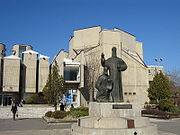 The state university of Ss. Cyril and Methodius.
The state university of Ss. Cyril and Methodius.
Statistics from the 2002 census showed that a majority of citizens of the city, or 193,425 people, had stopped their education after finishing high school, while 107,408 people had stopped after finishing only elementary school. 14,194 people had gone to university, 49,554 had received a baccalaureate degree, 1,777 had received a Master's degree, and 1,682 had received a PhD. Finally, 11,259 people had no education and 28,292 had an incomplete education. 97.5% of the population of the city over ten years of age is literate. This figure is slightly higher than the national average that of 96.1%.[71] In general, the people from Skopje have easier access to education than other Macedonians.[72]
The city has several universities. The largest and the oldest is the Ss. Cyril and Methodius University. This public university was founded in 1949 with three faculties. Since then, it has expanded to 23 faculties, 10 institutes, and over 36,000 students.[73] Since the independence of Macedonia, new universities, mostly private, have been opened. The European University was established in 2001 and has faculties of economics, computer science, law, political science and art and design.[74] FON University, founded in 2003, has faculties of law, political science and international relations, foreign languages, investigation and security, environmental management, economics, technology and communication information, sports, design and multimedia and philosophy.[75] The American University College was opened in 2005 and has faculties of business administration, political science, foreign languages, architecture and design, computer science and law.[76] The Yahya Kemal College, named after the Turkish poet Yahya Kemal Beyatlı who was born in Skopje, opened in 1996.[77] In 2008, Skopje had 21 colleges.[78]
Religion
The two religions that have had the greatest influence on the city are Orthodox Christianity, represented by the Diocese of Skopje, under the Macedonian Orthodox Church, and Islam. There also are smaller minorities of Catholics, Protestants and Jews.[61]
Skopje has a diversity of churches and monasteries built in different styles - from Byzantine to modern architecture. One of the Byzantine examples is the Church of St. Panteleimon in Gorno Nerezi, near Skopje. The church contains Comnenian art and it was finished in the 1164. The church is known for its frescoes, representing a pinnacle of the 12th-century trend of intimacy and spirituality. They are often compared with similarly delicate works by Giotto, who worked 140 years later.[79] Another notable example of Byzantine architecture is Marko's Monastery which was built by Prince Marko in the 1366. The Churches of St. Nikita and St. Andrea both date from the 1300s and share Byzantine characteristics. The Church of Holy Mother of God was built in 1204 and later completely destroyed in a fire. The old church was previously rebuilt and consecrated in 1835, but destroyed during the 1963 Skopje earthquake. The present-day church's reconstruction began on 2 October 2002.[79] Despite Ottoman policies prohibiting the building of churches, there are a few churches in Skopje built during that period. The Church of Holy Salvation was built in the 16th century and is located between the Old Bazaar and Skopje Fortress. The revolutionary Goce Delčev is buried in the church courtyard. The Church of Saint Demetrius was built in the 18th century on the grounds of an older church from the 13th century. This church was an Orthodox cathedral church before the construction of the present-day cathedral church of St. Clement of Ohrid, which is an example of modern architecture. Built in 1972, the church was consecrated in 1990, on the 1150th anniversary of the birth of the church patron, St. Clement of Ohrid.[79] There is also a Catholic church named Holy Heart of Jesus in the center of the city.
The largest concentration of the mosques in the city is in the Old Bazaar, a part of the city with typical Ottoman Islamic architecture. One of the most eminent mosques is the Mustapha Pasha Mosque which was built in 1492 by Mustafa Paşa on an older Christian site.[80] It is an endowment of Mustapha Pasha, an eminent figure in the Turkish state during the rule of Sultan Bayezid II and Sultan Selim I.[81] Other important mosque include Isa Bey Mosque. Situated on the outskirts of the bazaar, this mosque was built as a memorial for Isa Bey after his death. The mosque has two dominant domes and five smaller ones above the porch area. The Ishak Bey Mosque was constructed in 1439 in the northern part of the Old Bazaar. The mosque's minaret rises 30 meters (98.4 feet). Ishak Bey, who retired in the city, is buried in the türbe behind the mosque.[82]
-
Church of Saint Demetrius at Marko's Monastery
Transport
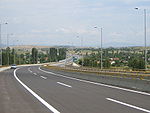 The E65 section of the northern bypass.
The E65 section of the northern bypass.
Since the 1990s, Skopje's standing as a major Southeast European transportation hub has increased. The city is situated at an intersection of two main European transport corridors – Corridor VIII (east-west) and Corridor X (north-south). This significance of the city is being enhanced by the construction of new highways on the two transversals, a new Skopje ring road, and the ongoing extension and modernization of Skopje Alexander the Great Airport.[52]
Airports:
Skopje's single international airport, Skopje Alexander the Great Airport, is located in Petrovec Municipality, roughly 22 kilometers east of the city centre. The airport has been given under concession to the Turkish company TAV, which is contracted to invest €200 million in the expansion and renovations of both the Skopje and Ohrid Airports, as well as the construction of a new cargo airport in Štip. Skopje is connected by air every year with Amsterdam, Belgrade, Berlin, Budapest, Bursa, Brussels, Düsseldorf, Hamburg, Istanbul, Ljubljana, London, Podgorica, Prague, Rome, Sofia, Vienna, Zagreb and Zurich.[83]
Highways:
The E75 highway connecting Vardø in Norway and Crete in Greece runs just east of Skopje, thus linking most of Europe with the Macedonian capital. The E75 highway connects the Macedonian cities of Kumanovo, Veles, Negotino, and Gevgelija.
The E65 highway runs through the northern and western edges of the city and is part of the 26.5 km long Skopje Northern Bypass. The E65 in Macedonia also connects Tetovo, Gostivar, Kičevo, Ohrid and Bitola
Railways:
The Skopje Central Railway Station is approximately 2 kilometers east of the city centre. It is part of the "Transportation Center" complex, built in the 1970s to replace the first railway station that was destroyed by the 1963 earthquake. The new station has 10 platforms and is suspended on a massive concrete bridge about 2 km long. In 2010, Makedonski Železnici joined Cargo 10, a joint venture with other railways in the region.[84]
Buses:
The main Skopje bus station is 2 kilometers east of the city center and is located in the Transportation Centre which also houses the central railway station. City buses run through the whole city connecting different neighborhoods as well as the smaller surrounding towns. In 2011, the old city buses were replaced with 84 new buses, built in Ukraine.[85] The station is also the hub for intercity and international bus routes. There are several departures daily for Ohrid, Bitola, Thessaloniki, Belgrade, Sofia, and other cities.
Tramway:
The City of Skopje is planning to build a tramway across the city.[86]
Main sights
Landmarks
Skopje's Kale Fortress.
The present Skopje Fortress was originally built by the Byzantines in the 6th century. After the 1963 Skopje earthquake, the fortress's circular, rectangular and square towers were conserved and restored. It is today one of the most popular tourist spots in the city. The Stone Bridge was built under the patronage of Sultan Mehmed II the Conqueror between 1451 and 1469. This bridge represents the connection between Skopje's past and present, and is featured in the Coat of arms of Skopje.[55] The bridge connects Skopje's main square, Macedonia Square, to the city's Old Bazaar. The square was dramatically increased in size by the destruction of the massive neoclassical National Bank and Army House during the 1963 earthquake. Another well-known Skopje building is Ristiḱ Palace. In 2010, two monuments of Goce Delcev and Dame Gruev were erected near the Stone Bridge.[87]
The Old Town was one of the largest and most significant oriental bazaars in the Balkans.[88] It is situated on the eastern bank of the Vardar River and represents a mixture of Eastern and Western culture. It features mosques, inns, a clocktower, a bezisten, Turkish baths, churches, and various shops.
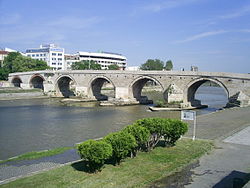 The Stone Bridge and the Vardar River.
The Stone Bridge and the Vardar River.
The bezisten, a covered market, was built in the 15th century by Gazi Ishak Bey, the Sultan's Skopje regent. It was destroyed by a fire in 1689 and was later rebuilt. The bezisten has looked the same since its renovation in 1899. Skopje's clock tower, built in the 16th century on the foundations of an older edifice, is located just north of the Sultan Murad Mosque. The Čifte Hammam, a Turkish bath, is located in the centre of the Old Bazaar and was built under Isa Bey. The Daut Paşa Hammam, built under Daut Paşa, Grand Vesir of East Rumelia, dates from the 15th century. Today the both hammams are art galleries.
The bazaar also includes medieval inns like the Kapan An, Suli An, and the Kuršumli An. The latter features architecturally significant arches and domes. Because lead was used to top the structure, it became known as the Lead Inn. It was built by Musein Odza, the son of a scientist of Sultan Selim II's court, in the 16th century.[89] The building today features exhibits from the National Museum of Macedonia. Although Islamic architecture is predominant in the bazaar, there are several churches as well.
The Millennium Cross, situated on the peak of the mountain Vodno, is a tourist attraction. It was built to celebrate 2000 years of the existence of Christianity. The cross was built on the highest point of Vodno Mountain on a place known since the time of the Ottoman Empire as "Krstovar", meaning "Place of the cross", as there was a smaller cross situated there. There are several landmarks of Mother Teresa in Skopje, the city of her birth and childhood, including a marker of her birthplace, a statue, and a memorial house. The Memorial House of Mother Teresa was opened in early 2009.[90] An ancient Roman aqueduct survives to the north of the city, near the village of Vizbegovo. The date of its erection is unclear. During the Ottoman Empire, it provided water for public baths. Today, 55 of its stone arches remain standing.
-
Statues of Goce Delchev and Dame Gruev
-
Entrance to the Old Town
Culture
Skopje is the cultural hub of the Republic of Macedonia and, therefore, is home to many of the country's most important museums. One of these is the Museum of Contemporary Arts which is devoted to the preserving of contemporary art.[91] Тhe museum was created as part of the reconstruction following 1963 earthquake. The International Association of the Plastic arts called upon the artists of the world to assist in creating a collection of works of art by which they would support the vision of the city's reconstruction. The government of Poland held a national competition for the design of the building of the Museum of Contemporary Art and donated it to Skopje. The large park areas, which now contain many sculptures, surround the museum. The Museum of Macedonia, the Natural History Museum, and the Archives of Macedonia are other significant museums in Skopje.
The Skopje Jazz Festival has been held annually in October since 1981. It is part of the European Jazz Network and the European Forum of World Wide Festivals. The artists` profiles include fusion, acid jazz, Latin jazz, smooth jazz, and avant-garde jazz. Ray Charles, Tito Puente, Gotan Project, Al Di Meola, Youssou N'Dour, among others, have performed at the festival. Another music festival in Skopje is the Blues and Soul Festival. It is a relatively new event in the Macedonian cultural scene that occurs every summer in early July.[92] Past guests include Larry Coryell, Mick Taylor & the All-Stars Blues Band, Candy Dulfer & Funky Stuff, João Bosco, The Temptations, Tolo Marton Trio, Blues Wire, and Phil Guy.
The Skopje Cultural Summer Festival is a renowned cultural event that takes place in Skopje each year during the summer. The festival is a member of the International Festivals and Events Association (IFEA) and it includes musical concerts, operas, ballets, plays, art and photograph exhibitions, movies, and multimedia projects that gather 2,000 participants from around the world each year including St Petersburg Theatre, the Chamber Orchestra of the Bolshoi Theatre, Irina Arkhipova, Viktor Tretiakov, The Theatre of Shadows, Michel Dalberto, David Burgess.
May Opera Evenings is a festival that has occurred annually in Skopje since 1972 and is dedicated to promoting opera among the general public. Over the years, it has evolved into a stage on which artists from some 50 countries have performed. Another opera festival, the Open Youth Theatre Festival, was established in May 1976 by a group of young opera enthusiasts.[93] More than 250 theatrical performances have been presented at this festival so far, most of them being alternative, experimental theatre groups engaging young writers and actors. Recently, the festival became a member of the Brussels Informal European Theatre Meeting (IETM). Within the framework of the Open Youth Theatre, a Macedonian National Centre of the International Theatre Institute (ITI) was established, and at the 25th ITI World Congress in Munich in 1993, it became a regular member of the theatre association. The festival is now an international one representing groups from the former Yugoslavia, the United States, France, the former Soviet Union, Spain, Japan, Poland, Italy, the United Kingdom, India and other countries.
Nightlife
Skopje has a diverse nightlife. There is a large emphasis on casinos, many of which are associated with hotels, such as that of the Holiday Inn. Other casinos include Helios Metropol, Olympic, Bon Venon, and Sherry.[94] Among young people the most popular destinations are bars, discos, and nightclubs which can be found in the center and the City Park. Among the most popular nightclubs are Hard Rock, Maracana, B2, Havana and Colosseum where world famous disc jockeys and idiosyncratic local performances are frequent. In 2010, the Colosseum club was named fifth on a list of the best clubs in Southeastern Europe. Armin van Buuren, Above and Beyond, Shapeshifter are just some of the many musicians that have visited the club.[95] Nighttime concerts in local, regional and global music are often held at the Philip II National Arena and Boris Trajkovski Sports Center.[94] For middle-aged people, places for having fun are also the kafeanas where traditional Macedonian food is served and traditional Macedonian Music (Starogradska muzika) is played, but music from all the Balkans, particularly Serbian folk music is also popular. Apart from the traditional Macedonian restaurants, there are restaurants featuring international cuisines.[94] Some of the most popular cafés in Skopje are Café Trend, La Café, and Blue Café. The Old Bazaar was a popular nightlife destination in the past. The national government has created a project to revive nightlife in the Old Bazaar. The closing time in shops, cafés and restaurants was extended due to the high attendances recorded. In the bazaar's restaurants, along with the traditional Macedonian wine and food, dishes of the Ottoman cuisine are also served.[96]
Media
Skopje is the largest media center in Macedonia. Of the 818 newspapers surveyed in 2000 by the Ministry of Information, over 600 had their headquarters in Skopje. The daily Dnevnik, founded in 1996, with 60 000 runs per day is the most printed in the country. Also based in Skopje, Večer is pulled 50,000 copies and the state owns one third of its capital, as well as Nova Makedonija, reprinted 20,000 copies. Other major newspapers in Skopje, totally private, are Utrinski Vesnik (30,000 copies), Vest (25,000 copies) and Vreme (15,000 copies). Magazines Fokus (12,000 copies), Start (10,000 copies), and Denes (7,500 copies) also have their headquarters in Skopje.[97][98]
The city is home of the studios of Macedonian Radio-Television (MRT), the company's public radio and television. Founded in 1966, it operate withs three national broadcast channels, twenty-four hours at day. The most popular private televisions are A1 TV and Sitel. Kanal 5, Telma, Alfa TV and AlsatM are another major private television companies.[99] MRT also operates radio stations with national coverage, the private station Skopje's Kanal 77 is the only one to have such a span. Radio Antenna 5 and Metropolis are two other major private stations that have their headquarters in Skopje.[100]
Also, the city boasts big news agencies in the country, whether public, as the Macedonian Information Agency, or private agency as Makfax.[97]
Sports
Main article: Sports in SkopjeAs the capital and largest city of Macedonia, Skopje has many major sporting facilities. The city has three large swimming pools, two of which feature Olympic pools. These pools are particularly relevant to coaching water polo teams. Skopje also boasts many football stadiums, like Ilinden in Čair and Železarnica, which can accommodate between 4,000 and 4,500 spectators. The basketball court Kale can accommodate 5 000 people and the court of Jane Sandanski, 4000 people.[101]
Тhe largest stadium remains the Philip II Arena. The stadium, built in 1947 and named until 2008, Skopje Gradski Stadion[102] experienced a total renovation, begun in 2009 to meet the standards of FIFA. Fully renovated the stadium contains 32,580 seats,[103] and a health spa and fitness. The Boris Trajkovski Sports Center it's the largest sports complex in the country. It was opened in 2008 and named after president Boris Trajkovski, who died in 2004. It includes room dedicated to handball, basketball and volleyball, a bowling alley, a fitness area and an ice hokey court. Its main hall, which regularly hosts concerts, holds around 10,000 people.[104]
FK Vardar and FK Rabotnički are the two most popular football teams, playing in the first national league. Their workouts are held at Philip Arena II, like those of the national team. The city is also home to many smaller football clubs, as Makedonija GP Skopje, Skopje Sloga Jugomagnat or FK Madzar Solidarnost, who play at second or third national league. Another popular sport in Macedonia, the basketball is shown in particular by the teams KK Skopje Rabotnički, KK MZT and the Vardar, which are the first national league. Handball is illustrated by RK Vardar PRO and the women's club RK Kometal Gjorče Petrov and RK Metalurg, also in the Macedonian first league. The city has co-hosted 2008 European Women's Handball Championship together with Ohrid.[105]
People from Skopje
Further information: List of people from SkopjeNotable people from Skopje include:
- Justinian I, Byzantine Emperor
- Mother Teresa, Roman Catholic humanitarian
- Milčo Mančevski, film director
- Darko Pančev, former footballer
- Katarina Ivanovska, model
- Simon Trpčeski - pianist
International relations
See also: List of twin towns and sister cities in MacedoniaTwin towns – Sister cities
See also
- History of Skopje
- Sports in Skopje
- List of people from Skopje
- Old Bazaar, Skopje
References
- ^ a b Град Скопје. "Skopje – Capital of the Republic of Macedonia". skopje.com. http://skopje.com/page.php?id=48. Retrieved 2010-12-24.
- ^ The provincial at Rome: and, Rome and the Balkans 80BC-AD14, Liverpool University Press, Classical Studies and Ancient History, Authors Ronald Syme, Anthony Richard Birley, Publisher University of Exeter Press, 1999, ISBN 0859896323, 130.
- ^ Pannonia and Upper Moesia, Volume 4 of History of the provinces of the Roman Empire, Author András Mócsy, Publisher Routledge, 1974, ISBN 0710077149, p. 116.
- ^ Watkins, Thomas H., "Roman Legionary Fortresses and the Cities of Modern Europe", Military Affairs, Vol. 47, No. 1 (Feb., 1983)
- ^ N. G. L. Hammond, F. W. Walbank, A History of Macedonia: Volume III: 336-167 B.C., Oxford University Press, 1988, p.386
- ^ John Wilkes, The Illyrians, Wiley-Blackwell, 1996. p.86
- ^ "Climatological Normals of Skopje". Hong Kong Observatory. August 2011. http://www.weather.gov.hk/wxinfo/climat/world/eng/europe/gr_tu/skopje_e.htm. Retrieved 2010-09-05.
- ^ a b c d e f g h i j Град Скопје. "Official portal of City of Skopje – History". Skopje.gov.mk. http://www.skopje.gov.mk/EN/DesktopDefault.aspx?tabindex=0&tabid=46. Retrieved 2009-05-06.
- ^ a b In Your Pocket. "The 1963 earthquake in Skopje". inyourcpocket.com. http://www.inyourpocket.com/macedonia/skopje/the-1963-earthquake_56043f?more=1. Retrieved 2010-01-29.
- ^ BBC (26 July 1963). "On This Day: 26 July; 1963: Thousands killed in Yugoslav earthquake". bbc.com. http://news.bbc.co.uk/onthisday/hi/dates/stories/july/26/newsid_2721000/2721635.stm. Retrieved 2010-01-29.
- ^ a b Yugoslavia,Worlds and Travels, Larousse, 1989, p. 115
- ^ Агенција за иселеништво на Република Македонија. "Јанко Константинов". makemigration.com. http://www.makemigration.com/iselenistvo/default.asp?page=%D0%88%D0%B0%D0%BD%D0%BA%D0%BE%20%D0%9A%D0%BE%D0%BD%D1%81%D1%82%D0%B0%D0%BD%D1%82%D0%B8%D0%BD%D0%BE%D0%B2&submenu=13&type=dynamic&args=&mainmenu=4&subsubmenu=57&submenu2=-2. Retrieved 2010-01-29. (Macedonian)
- ^ a b c d e City of Skopje. "Strategy for Local Economic Development of the City of Skopje". skopje.gov.mk. http://www.skopje.gov.mk/en/images/File/Strategijata%20za%20LER%20na%20angliski.pdf. Retrieved 2010-01-29.
- ^ a b Balkan Insight (2010-06-24). "Critics Lash ‘Dated’ Aesthetics of Skopje 2014". balkaninsight.com. http://old.balkaninsight.com/en/main/analysis/29030/?tpl=299&ST1=Text&ST_T1=Article&ST_AS1=1&ST_max=1. Retrieved 2010-01-29.
- ^ Macedonian national treasures, Author Cvetan Grozdanovzdanov, Publisher Makedonska kniga, 1989 p. 61.
- ^ Macedonia yesterday and today Author Giorgio Nurigiani, Publisher Teleurope, 1967 p. 77.
- ^ The Cambridge Ancient History, John Boardman, Volume 13 of The Cambridge Ancient History, Author Averil Cameron, Contributor R. C. Blockley, Publisher Cambridge University Press, 1996, p. 570.
- ^ The Illyrians, Author John Wilkes, Publisher Wiley-Blackwell, 1995, ISBN 0631198075, p. 213.
- ^ Macedonia - Bradt Travel Guide, Author Thammy Evans, Publisher Bradt Travel Guides, 2010, ISBN 1841622974, p. 117.
- ^ Catholic Encyclopedia. "Scopia". newadvent.org. http://www.newadvent.org/cathen/13609c.htm. Retrieved 2010-01-30.
- ^ M. Meier, Justinian, 29: "481 or 482"; Moorhead (1994), p. 17: "about 482"; Maas (2005), p. 5: "around 483".
- ^ Researches in the highlands of Turkey: including visits to mounts Ida, Athos, Olympus, and Pelion, to the Mirdite Albanians, and other remote tribes, Henry Fanshawe Tozer, p. 371-2
- ^ [1] Archaeologia, or, Miscellaneous tracts relating to antiquity, Volume 49, Part 1, p. 141
- ^ [2] Travels in the Slavonic provinces, Georgina Mary Sebright and Adelina Paulina Irby, 1877, p. 160
- ^ Pavlov, Plamen (2002) (in Bulgarian). Цар Самуил и "Българската епопея". Sofia, Veliko Tarnovo: VMRO Rousse. http://www.vmro-rousse.hit.bg/Pl_Pavlov.html. Retrieved 2009-08-05.
- ^ World and Its Peoples – Google Böcker. Books.google.se. http://books.google.se/books?id=ML-aXrrBrv8C&pg=PA1680. Retrieved 2010-06-14.
- ^ a b "Macedonia :: The Ottoman Empire". Britannica. 2010. http://www.britannica.com/EBchecked/topic/354223/Macedonia/42800/The-Ottoman-Empire?anchor=ref476755. Retrieved 25 August 2010.
- ^ "Archeological exavations "Skopsko Kale"". skopskokale.com.mk. http://www.skopskokale.com.mk/en/aboutkale.php. Retrieved 2011-02-07. "The handwriting of the triod of the Khludov collection in the Moscow Historical Museum no. 162, completed on 6 January 1392, on the day of the Ottoman conquest of Skopje."
- ^ "The Church of St Spas - Skopje". National Tourism Portal of Macedonia. 2005-07. http://www.exploringmacedonia.com/?ItemID=60170837F99D7A4AAF93A56C3D280825. Retrieved 27 August 2010. "...half of it was constructed underground, due to the 17th century edict of the Turkish Sultan that prohibited Christian structures from being higher than mosques."
- ^ Jacques, Edwin E. (1994) The Albanians: an ethnic history from prehistoric times to the present McFarland, Jefferson, North Carolina, page 273, ISBN 0-89950-932-0
- ^ Jelavich, Barbara (1983) History of the Balkans: Twentieth Century (volume 2 of History of the Balkans) Cambridge University Press, New York, page 89, ISBN 0-521-27459-1
- ^ "An outline of macedonian history from ancient times to 1991". Embassy of the Republic of Macedonia London. 2010. http://www.macedonianembassy.org.uk/history.html. Retrieved 25 August 2010. "The period of expansion of medieval states on the Balkan and in Macedonia was followed by the occupation of the Ottoman Empire in the 14th century. Macedonia remained a part of the Ottoman Empire for 500 years, i.e. until 1912"
- ^ a b Zum (1913-05-17). "(HIS, P) Treaty of Peace between Greece, Bulgaria, Montenegro, Serbia on the one part and Turkey on the other part". skopje.gov.mk. http://www.zum.de/psm/div/tuerkei/mowat120.php. Retrieved 2010-01-29.
- ^ Rossos, Andrew (2008) Macedonia and the Macedonians: A History Hoover Institution Press, Stanford, California, page 135, ISBN 978-0-8179-4881-8
- ^ Jancar-Webster, Barbara (1989) Women & Revolution in Yugoslavia, 1941–1945 Arden Press, Denver, Colorado, page 37, ISBN 0-912869-09-7
- ^ Schreiber, Gerhard; Stegemann, Bernd and Vogel, Detlef (1995) Germany and the Second World War, Vol. 3. The Mediterranean, south-east Europe, and North Africa (translated from German) Oxford Clarendon Press, Oxford, England, page 504, note 38 citing a Werhmacht report, ISBN 0-19-822884-8
- ^ Mitrovski, Boro; Glišić, Venceslav and Ristovski, Tomo (1971) The Bulgarian Army in Yugoslavia 1941–1945 (translated from Bugarska vojska u Jugoslaviji 1941–1945) Medunarodna politika, Belgrade, page 35, OCLC 3241584
- ^ Phillips, John (2004) Macedonia: warlords and rebels in the Balkans Yale University Press, New Haven, Connecticut, page 32, ISBN 0-300-10268-2
- ^ Mitrovski, Boro; Glišić, Venceslav and Ristovski, Tomo (1971) The Bulgarian Army in Yugoslavia 1941–1945 (translated from Bugarska vojska u Jugoslaviji 1941–1945) Medunarodna politika, Belgrade, page 80, OCLC 3241584
- ^ [3],United States Holocaust Museum, Holocaust Encyclopedia
- ^ [4] Escape Through the Balkans: The Autobiography of Irene Grünbaum, Irene Grünbaum, Katherine Morris, U of Nebraska Press, 1999 p.xvi
- ^ Volume 5 of Istoria na Bŭlgarite, Author Georgi Bakalov, TRUD Publishers, 2007, ISBN 9546212350, p. 567.
- ^ The SS hunter battalions: the hidden history of the Nazi resistance movement 1944-45, Author Perry Biddiscombe, Publisher Tempus, 2006, ISBN 0752439383, p. 155.
- ^ Bulgarian-Yugoslavian political relations, 1944-1945, Georgi Daskalov, Kliment Ohridski University, 1989, p. 113.
- ^ Dr. Cvetan Cvetkovski, Skopje University, Faculty of Law. ""Constitutional history of the Republic of Macedonia", section "1. Creation of the contemporary Macedonian state during the Second World War (1941–1945)", Centre for European Constitutional Law". cecl.gr. http://www.cecl.gr/RigasNetwork/databank/REPORTS/r1/Fyrom_R1_Cvetkovski.html. Retrieved 2010-01-29.
- ^ a b Department of Earth Sciences, University of Trieste, Trieste, Italy. "Seismic Ground Motion Estimates for the M6.1 earthquake of July 26, 1963 at Skopje, Republic of Macedonia". units.it. http://www.univ.trieste.it/~dst/RAF06/People/Denis/Skopje9.pdf. Retrieved 2010-01-30.
- ^ Incorporated Research Institutions for Seismology. "1963 Skopje (Macedonia) Earthquake, SeismoArchives". iris.edu. http://www.iris.edu/seismo/quakes/1963skopje/. Retrieved 2010-01-30.
- ^ a b Marking the 44th anniversary of the catastrophic 1963 Skopje earthquake MRT, Thursday, 26 July 2007
- ^ Dnevnik newspaper (2008-12-28). "Скопскиот стадион ќе се вика "Арена Филип Македонски"". dnevnik.com.mk. http://www.dnevnik.com.mk/?itemID=89976B5EB501C649B6CB54F97C08DEA8&arc=1. Retrieved 2010-01-30. (Macedonian)
- ^ Dnevnik newspaper. "Macedonia to host Spain". macedonianfootball.com. http://www.macedonianfootball.com/200907071426/News/Macedonia-to-host-Spain.html. Retrieved 2010-01-30.
- ^ Večer Online. "Близу Александар Велики ќе се гради хотел де лукс". vecer.com.mk. http://www.vecer.com.mk/default.asp?ItemID=F6618108C035A040A707A955E773DA44. Retrieved 2010-01-30. (Macedonian)
- ^ a b World Bulletin (2008-11-25). "Turkey's TAV signs deal for Macedonian airports". worldbulletin.net. http://www.worldbulletin.net/news_detail.php?id=28735/. Retrieved 2010-01-30.
- ^ Град Скопје. "City symbols". skopje.gov.mk. http://www.skopje.gov.mk/EN/DesktopDefault.aspx?tabindex=0&tabid=34. Retrieved 2010-07-16.
- ^ Flagspot. "Skopje (Capital city, Macedonia)". flagspot.net. http://flagspot.net/flags/mk-skop.html. Retrieved 2010-07-16.
- ^ a b Heraldry of the World (ngw.nl). "City symbols". http://www.ngw.nl/int/oveur/mac/skopje.htm. Retrieved 2011-01-30.
- ^ A1 TV Online (2009-04-06). "Груевски му се заблагодари на Црвенковски". a1.com.mk. http://www.a1.com.mk/vesti/default.aspx?VestID=106803. Retrieved 2011-02-05. (Macedonian)
- ^ Encarta Encyclopedia, 2008 – Skopje
- ^ "Macedonian Stock Exhange, Inc. Skopje". mse.com.mk. http://www.mse.com.mk/Page.aspx?ContentID=39. Retrieved 2011-07-02.
- ^ a b "Budget 2010". Official website of the city. 2011-03-15. http://www.skopje.gov.mk/userfiles/file/VKUPEN%20buxet%20na%20Grad%20Skopje%20za%202010.pdf.(Macedonian)
- ^ "Budget 2009". Official website of the city. 2011-03-15. http://www.skopje.gov.mk/images/File/BUDGET%20JUNI%202009%20MK.pdf.
- ^ a b c d Government of the Republic of Macedonia. "2002 census results". stat.gov.mk. http://www.stat.gov.mk/pdf/kniga_13.pdf. Retrieved 2010-01-30.
- ^ The Republic of Macedonia: A newcomer in the European community, eds. Christophe Chiclet and Bernard Lory, Les Cahiers de Confluence, ed. The harmattan, 1998, p. 67
- ^ cit.eds. Christophe Chiclet and Bernard Lory, Les Cahiers de Confluence, ed. The harmattan, 1998, p. 78
- ^ a b Op. cit., Georges Castellan, éd. Arméline, 2003, p. 78
- ^ Central and Eastern European Library. "Macedonian census results – controversy or reality?". ceeol.com. http://www.ceeol.com/aspx/getdocument.aspx?logid=5&id=b5ea1b81-afdb-4026-b695-97a2ca6e21d3. Retrieved 2010-01-30.
- ^ "Institute for Therapeutic Radiology and Oncology – Skopje". oncology.org.mk. http://www.oncology.org.mk/en/default2.asp?active_page_id=118. Retrieved 2010-01-30.
- ^ "Hospital Philip II – Skopje, Republic of Macedonia". cardiosurgery.com.mk. http://www.cardiosurgery.com.mk/EN/DesktopDefault.aspx?tabindex=0&tabid=1. Retrieved 2010-01-30.
- ^ "Website of the Clinical Centre, Skopje". ukcs.org.mk. http://www.ukcs.org.mk/jn/zak_reg.php#. Retrieved 2010-01-30. (Macedonian)
- ^ a b c Republic of Macedonia – National Bureau of Statistics, birth and mortality in urban municipalities
- ^ PopulationData. "PopulationData.net – Macedoine". populationdata.net. http://www.populationdata.net/pays/europe/macedoine.html. Retrieved 2011-01-01. (French)
- ^ CIA. "CIA, The World Factbook - Macedonia". cia.gov. https://www.cia.gov/library/publications/the-world-factbook/geos/mk.html. Retrieved 2010-01-29.
- ^ Official website of Skopje. "Strategy for Local Economic Development of the City of Skopje – comparison of national and local figures". skopje.gov.mk. http://www.skopje.gov.mk/en/images/File/Strategijata%20za%20LER%20na%20angliski.pdf. Retrieved 2011-06-30.
- ^ Ss. Cyril and Methodius University of Skopje. "Ss. Cyril and Methodius University - Skopje, Official website". ukim.edu.mk. http://www.ukim.edu.mk/index.php?lan=en&pon=. Retrieved 2010-01-29.
- ^ European University - Republic of Macedonia. "European University - Skopje, Official website". eurm.edu.mk. http://www.eurm.edu.mk/index.php?option=com_content&view=article&id=2&Itemid=3&lang=en. Retrieved 2010-01-29.
- ^ FON University. "FON University - Skopje, Official website". fon.edu.mk. http://www.fon.edu.mk/Default.aspx?ln=en. Retrieved 2010-01-29.
- ^ American University College, Skopje. "Website of American College in Skopje". uacs.edu.mk. http://www.uacs.edu.mk/. Retrieved 2010-01-29.
- ^ Yahya Kemal College. "Yahya Kemal College, Republic of Macedonia". yahyakemalcollege.edu.mk. http://yahyakemalcollege.edu.mk/. Retrieved 2010-01-29.
- ^ City of Skopje. "Official site of the city – Schools and Education". skopje.gov.mk. http://www.skopje.gov.mk/EN/DesktopDefault.aspx?tabindex=0&tabid=31. Retrieved 2010-01-29.
- ^ a b c Macedonian Cultural Information Centre. "Macedonian Cities - Skopje Churches". macedonia.co.uk. http://www.macedonia.co.uk/client/index1.aspx?page=388. Retrieved 2010-01-29.
- ^ Old Skopje. "The Mustapha Pasha Mosque and the Turbe". oldskopje.net. http://www.oldskopje.net/Monuments/Mosques/24.html. Retrieved 2010-01-29.
- ^ Old Skopje. "Mustafa Pasha Mosque". inyourpocket.com. http://www.inyourpocket.com/macedonia/skopje/sightseeing/ottoman-skopje/Mustafa-Pasha-Mosque_29095v. Retrieved 2010-01-29.
- ^ In Your Pocket. "Ishak Bey Mosque". inyourpocket.com. http://www.inyourpocket.com/macedonia/skopje/sightseeing/ottoman-skopje/Ishak-Bey-Mosque-29096v. Retrieved 2011-08-02.
- ^ TAV Macedonia (15 March 2011). "Destinations". Skopje Airport, Macedonia. http://skp.airports.com.mk/default.aspx?ItemID=359.
- ^ "Macedonian railways to join Cargo 10". ICT magazine. http://www.ictmag.info/politics/macedonian-railways-to-join-cargo-10. Retrieved 2010-09-26.
- ^ "За две недели нови автобуси низ скопските улици". kurir.mk. http://kurir.mk/republika/skopje/17442-Za-dve-nedeli-novi-avtobusi-niz-skopskite-ulici. Retrieved 2011-02-01.
- ^ "Избрани консултантите за трамвај во Скопје". A1 TV Online. http://www.a1.com.mk/vesti/default.aspx?VestID=130574. Retrieved 2011-02-03. (Macedonian)
- ^ MIA. "Goce Delcev, Dame Gruev monuments erected at Skopje square". mia.com.mk. http://www.mia.com.mk/default.aspx?vId=73558550&lId=2&pmId=505. Retrieved 2010-01-29.
- ^ Macedonia National Tourism Portal. "Old Bazaar - Skopje". exploringmacedonia.com. http://www.exploringmacedonia.com/default.asp?ItemID=7F8C63EBC722BE42A26410EDD0DE8F9C. Retrieved 2010-01-29.
- ^ Soros. "Kursumli an, Skopje". soros.org.mk. http://www.soros.org.mk/konkurs/076/angver/kursumli_an.html. Retrieved 2010-01-29.
- ^ "Memorial House of Mother Teresa - Opening". memorialhouseofmotherteresa.org. http://www.memorialhouseofmotherteresa.org/en/the-museum/opening-. Retrieved 2011-07-02.
- ^ "Museum of Contemporary Art - Skopje, Official website". http://www.msuskopje.org.mk/index.php. Retrieved 2011-02-05.
- ^ Barikada - World Of Music - Svastara - 2007. "Barikada - World Of Music". Barikada.com. http://www.barikada.com/svastara/2007/2007-06-26_blues_and_soul_2007.php. Retrieved 2010-01-26.
- ^ Kadmus Arts. "Youth Open Theater YOT (Mlad Otvoren Teatar MOT)". kadmusarts.com. http://www.kadmusarts.com/festivals/1582.html. Retrieved 2010-01-26.
- ^ a b c Trip Advisor. "Skopje: Nightlife". tripadvisor.com. http://www.tripadvisor.com/Travel-g295110-c17456/Skopje:Republic-Of-Macedonia:Nightlife.html. Retrieved 2011-05-02.
- ^ Nova Makedonija Online. ""Колосеум" меѓу најдобрите пет клуба во Југоисточна Европа". daily.mk. http://daily.mk/cluster3/85f8c795814c87a8cbb24041466d94c8/368735. Retrieved 2011-05-02.
- ^ Vest Online. "Нов живот на старата скопска чаршија". vest.com.mk. http://www.vest.com.mk/?ItemID=F602DD424FAD5E4B8771B653206B91FE&arc=1. Retrieved 2011-05-02.
- ^ a b Christopher D. Karadjov. "Macedonia Press, Media, TV, Radios, Newspapers". Press Reference. http://www.pressreference.com/Ky-Ma/Macedonia.html. Retrieved 2011-03-13.
- ^ "Macedonia Newspapers and Magazines Online". World Press.org. http://www.worldpress.org/newspapers/EUROPE/Macedonia.cfm. Retrieved 2011-03-13.
- ^ "Macedonia Newspapers and News Media Guide". ABYZ News Links. http://www.abyznewslinks.com/maced.htm. Retrieved 2011-03-13.
- ^ "Macedonia country profile". BBC News. http://news.bbc.co.uk/1/hi/world/europe/country_profiles/1067125.stm. Retrieved 2011-03-13.
- ^ "Stadiums in the FYR Macedonia". World Stadiums. http://www.worldstadiums.com/europe/countries/macedonia.shtml. Retrieved 2011-03-13.
- ^ "Избрани имиња на спортските објекти". Večer. 2010. http://www.vecer.com.mk/?ItemID=BF8801930BF6C344B62A5418CCC2853D. Retrieved 2011-03-13.
- ^ "Ексклузивно: Надворешниот изглед на "Филип Втори"". Kurir.mk. http://kurir.mk/makedonija/vesti/28430-Ekskluzivno-Nadvoresniot-izgled-na-Filip-Vtori. Retrieved 2011-06-15.
- ^ "Boris Trajkovski Sports Hall". European Handball Federation. 2008. http://www.ehf-euro.com/Boris-Trajkovski.861.0.html. Retrieved 2011-03-13.
- ^ "Womens' Euro 2008". European Handball Federation. 2008. http://www.ehf-euro.com/Women-s-EURO-2008.915.0.html. Retrieved 2011-03-13.
- ^ a b c d e f g h i j k l m n o "Official portal of City of Skopje – Skopje Sister Cities". 2006–2009 City of Skopje. http://www.skopje.gov.mk/EN/DesktopDefault.aspx?tabindex=0&tabid=69. Retrieved 2009-07-14.
- ^ "City of Belgrade - International Cooperation". Beograd.rs. http://www.beograd.rs/cms/view.php?id=1225698. Retrieved 2010-01-25.
- ^ "Sister Cities of Istanbul". http://www.greatistanbul.com/sister_cities.htm. Retrieved 2007-09-08.
- ^ Erdem, Selim Efe (2003-11-03). "İstanbul'a 49 kardeş" (in Turkish). Radikal. http://www.radikal.com.tr/haber.php?haberno=94185. Retrieved 2009-08-05. "49 sister cities in 2003"
- ^ daenet d.o.o.. "Sarajevo Official Web Site : Sister cities". Sarajevo.ba. http://www.sarajevo.ba/en/stream.php?kat=160. Retrieved 2009-05-06.
Further reading
- The Republic of Macedonia: A newcomer to the European mainstream, eds. Christophe Chiclet and Bernard Lory, Confluence of the Cahiers, ed. Harmattan, 1998.
- An unknown country: Macedonia, Georges Castellan, ed. Arméline, 2003.
External links
- Discover Skopje
- City of Skopje Official Portal
- Skopje travel guide
- Skopje at night, picture gallery.

Čučer-Sandevo, Lipkovo 
Želino, Jegunovce 
Aračinovo, Ilinden  Greater Skopje
Greater Skopje 

Studeničani, Sopište Petrovec Cities and towns in the Republic of Macedonia Berovo · Bitola · Bogdanci · Debar · Delčevo · Demir Hisar · Demir Kapija · Gevgelija · Gostivar · Kavadarci · Kičevo · Kočani · Kratovo · Kriva Palanka · Kruševo · Kumanovo · Makedonska Kamenica · Makedonski Brod · Negotino · Ohrid · Pehčevo · Prilep · Probištip · Radoviš · Resen · Skopje · Struga · Strumica · Sveti Nikole · Štip · Tetovo · Valandovo · Veles · Vinica
Capitals of European states and territories Capitals of non-sovereign territories or constituent nations shown in SmallCaps Western Northern Central Southern Eastern Amsterdam, 6 Netherlands
Andorra la Vella, Andorra
Belfast, Northern Ireland
Brussels, 5 Belgium
Douglas, Isle of Man 4
Cardiff, Wales
Dublin, Ireland
Edinburgh, Scotland
Lisbon, Portugal
London, United Kingdom, England
Luxembourg, Luxembourg
Madrid, Spain
Monaco, Monaco
Paris, France
Saint Helier, Jersey 4
Saint Peter Port, Guernsey 4Ankara, Turkey 1
Athens, Greece
Gibraltar, Gibraltar 4
Nicosia, Cyprus 2
North Nicosia, Northern Cyprus 2, 3
Podgorica, Montenegro
Pristina, Kosovo 3
Rome, Italy
San Marino, San Marino
Sarajevo, Bosnia and Herzegovina
Skopje, Republic of Macedonia
Sofia, Bulgaria
Tirana, Albania
Valletta, Malta
Vatican City, Vatican CityAstana, Kazakhstan 1
Baku, Azerbaijan 1
Bucharest, Romania
Chişinău, Moldova
Kiev, Ukraine
Minsk, Belarus
Moscow, Russia 1
Stepanakert, Nagorno-Karabakh 2, 3
Sukhumi, Abkhazia 2, 3
Tbilisi, Georgia 1
Tiraspol, Transnistria 3
Tskhinvali, South Ossetia 2, 3
Yerevan, Armenia 11 Transcontinental country. 2 Entirely in Southwest Asia but having socio-political connections with Europe. 3 Partially recognised country. 4 Crown Dependency or Overseas Territory of the United Kingdom. 5 Also the seat of the European Union, see Location of European Union institutions and Brussels and the European Union. 6 Also the capital of the Kingdom of the Netherlands. 7 Also the capital of the Kingdom of Denmark. Capital cities of the Candidate Countries of the European Union 
Historical capitals of Serbia 641–950 Destinikon
950–1276 Ras1818–1841 Kragujevac
1849–1860 Temišvar
1914–1915 Kragujevac
1915 Nišsince 1841 Belgrade Historical Capitals of Bulgaria Categories:- Former capitals of Serbia
- Former capitals of Bulgaria
- Skopje
- Ancient Greek cities
- Capitals in Europe
- Cities in the Republic of Macedonia
- Turkish communities in the Republic of Macedonia
Wikimedia Foundation. 2010.

